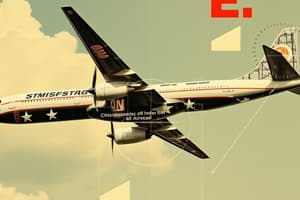Podcast
Questions and Answers
To takeoff from a secondary airport, a pilot must establish comm on the ground if not able, then as soon as practicable.
To takeoff from a secondary airport, a pilot must establish comm on the ground if not able, then as soon as practicable.
True
What are the Class C requirements?
What are the Class C requirements?
Two way radio communications and a mode C transponder.
Two-way communication must be established with the air traffic control facility having jurisdiction over the area prior to entering which airspace?
Two-way communication must be established with the air traffic control facility having jurisdiction over the area prior to entering which airspace?
Class C
What minimum radio equipment is required for operation within Class C airspace?
What minimum radio equipment is required for operation within Class C airspace?
What minimum radio equipment is required to land and takeoff at Norfolk International?
What minimum radio equipment is required to land and takeoff at Norfolk International?
All operations within Class C airspace must be in what type of aircraft?
All operations within Class C airspace must be in what type of aircraft?
Under what condition may an aircraft operate from a satellite airport within Class C airspace?
Under what condition may an aircraft operate from a satellite airport within Class C airspace?
Which initial action should a pilot take prior to entering Class C airspace?
Which initial action should a pilot take prior to entering Class C airspace?
Flashcards are hidden until you start studying
Study Notes
Class C Airspace Overview
- To take off from a secondary airport, establish communication on the ground if able; otherwise, do so as soon as practicable after takeoff.
- Class C airspace requires two-way radio communications and a Mode C transponder for aircraft operations.
Communication Requirements
- Two-way communication with the controlling air traffic facility must be established before entering Class C airspace.
- The pilot should contact approach control using the appropriate frequency prior to entering Class C airspace.
Minimum Equipment for Class C Operations
- Aircraft must be equipped with:
- Two-way radio communications equipment.
- A 4096-code transponder.
- An encoding altimeter.
Landing and Takeoff Requirements
- Minimum radio equipment for landing and taking off at Norfolk International Airport includes:
- Mode C transponder.
- Two-way radio communications.
Operations from Satellite Airports
- An aircraft operating from a satellite airport within Class C airspace must have the pilot contact Air Traffic Control (ATC) as soon as practicable after takeoff.
- All operations must be conducted in an aircraft equipped with a 4096-code transponder that has Mode C encoding capability.
Studying That Suits You
Use AI to generate personalized quizzes and flashcards to suit your learning preferences.




